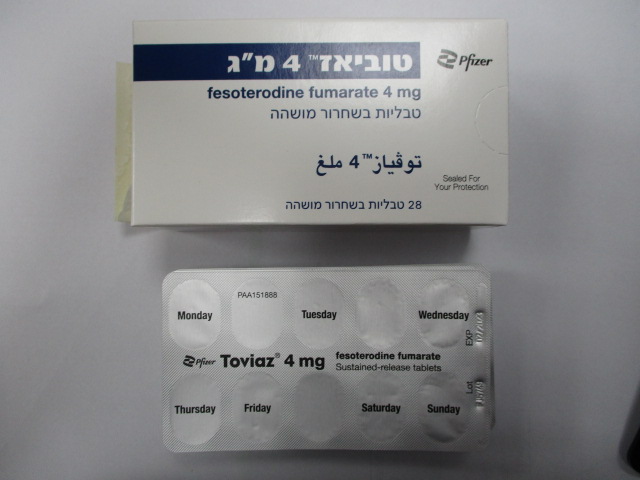Quest for the right Drug

טוביאז 4 מ"ג TOVIAZ 4 MG (FESOTERODINE FUMARATE)
תרופה במרשם
תרופה בסל
נרקוטיקה
ציטוטוקסיקה
צורת מתן:
פומי : PER OS
צורת מינון:
טבליות עם שחרור מושהה : TABLETS SUSTAINED RELEASE
עלון לרופא
מינוניםPosology התוויות
Indications תופעות לוואי
Adverse reactions התוויות נגד
Contraindications אינטראקציות
Interactions מינון יתר
Overdose הריון/הנקה
Pregnancy & Lactation אוכלוסיות מיוחדות
Special populations תכונות פרמקולוגיות
Pharmacological properties מידע רוקחי
Pharmaceutical particulars אזהרת שימוש
Special Warning עלון לרופא
Physicians Leaflet
Adverse reactions : תופעות לוואי
4.8 Undesirable effects Summary of the safety profile The safety of fesoterodine was evaluated in placebo-controlled clinical studies in a total of 2859 patients with overactive bladder, of which 780 received placebo. Due to the pharmacological properties of fesoterodine, treatment may cause mild to moderate antimuscarinic effects like dry mouth, dry eye, dyspepsia and constipation. Urinary retention may occur uncommonly. Dry mouth, the only very common adverse reactions, occurred with a frequency of 28.8% in the fesoterodine group compared to 8.5% in the placebo group. The majority of adverse reactions occurred during the first month of treatment with the exception of cases classified as urinary retention or post void residual urine greater than 200 ml, which could occur after long term treatment and was more common in male than female subjects. Tabulated list of adverse reactions The table below gives the frequency of treatment emergent adverse reactions from placebo-controlled clinical trials and from post-marketing experience. The adverse reactions are reported in this table with the following frequency convention: very common (≥1/10), common (≥1/100 to <1/10), uncommon (≥1/1,000 to <1/100), rare (≥1/10,000 to <1/1,000). Within each frequency grouping, adverse reactions are presented in order of decreasing seriousness. System organ class Very common Common Uncommon Rare Infections and Urinary tract infestations infection Psychiatric disorders Insomnia Confusional state System organ class Very common Common Uncommon Rare Nervous system Dizziness; Dysgeusia; disorders Headache Somnolence Eye disorders Dry eye Blurred vision Ear and labyrinth Vertigo disorders Cardiac disorders Tachycardia; Palpitations Respiratory, thoracic Dry throat Pharyngolaryng and mediastinal eal pain; Cough; disorders Nasal dryness Gastrointestinal Dry mouth Abdominal pain; Abdominal Hypoaesthesia disorders Diarrhoea; discomfort; oral Dyspepsia; Flatulence, Constipation; Gastroesophage Nausea al reflux Hepatobiliary disorders ALT increased; GGT increased Skin and subcutaneous Rash; Dry skin; Angioedema; tissue disorders Pruritus Urticaria Renal and urinary Dysuria Urinary disorders retention (including feeling of residual urine; micturition disorder); Urinary hesitation General disorders and Fatigue administration site conditions Description of selected adverse reactions In clinical trials of fesoterodine, cases of markedly elevated liver enzymes were reported with the occurrence frequency no different from the placebo group. The relation to fesoterodine treatment is unclear. Electrocardiograms were obtained from 782 patients treated with 4 mg, 785 treated with 8 mg, 222 treated with 12 mg fesoterodine and 780 with placebo. The heart rate corrected QT interval in fesoterodine treated patients did not differ from that seen in placebo treated patients. The incidence rates of QTc ≥500 ms post baseline or QTc increase of ≥60 ms is 1.9%, 1.3%, 1.4% and 1.5%, for fesoterodine 4 mg, 8 mg, 12 mg and placebo, respectively. The clinical relevance of these findings will depend on individual patient risk factors and susceptibilities present (see section 4.4). Post-marketing cases of urinary retention requiring catheterisation have been described, generally within the first week of treatment with fesoterodine. They have mainly involved elderly (≥ 65 years) male patients with a history consistent with benign prostatic hyperplasia (see section 4.4). Reporting of suspected adverse reactions Reporting suspected adverse reactions after authorisation of the medicinal product is important. It allows continued monitoring of the benefit/risk balance of the medicinal product. Any suspected adverse event should be reported to the Ministry of Health according to the National form https://sideeffects.health.gov.il/

מסגרת הכללה בסל
התוויות הכלולות במסגרת הסל
| התוויה | תאריך הכללה | תחום קליני | Class Effect | מצב מחלה |
|---|---|---|---|---|
| לטיפול בשלפחות שתן פעילה ביתר | FESOTERODINE, SOLIFENACIN, TOLTERODINE, TROSPIUM |
שימוש לפי פנקס קופ''ח כללית 1994
לא צוין
תאריך הכללה מקורי בסל
23/01/2011
הגבלות
תרופה מוגבלת לרישום ע'י רופא מומחה או הגבלה אחרת
מידע נוסף
